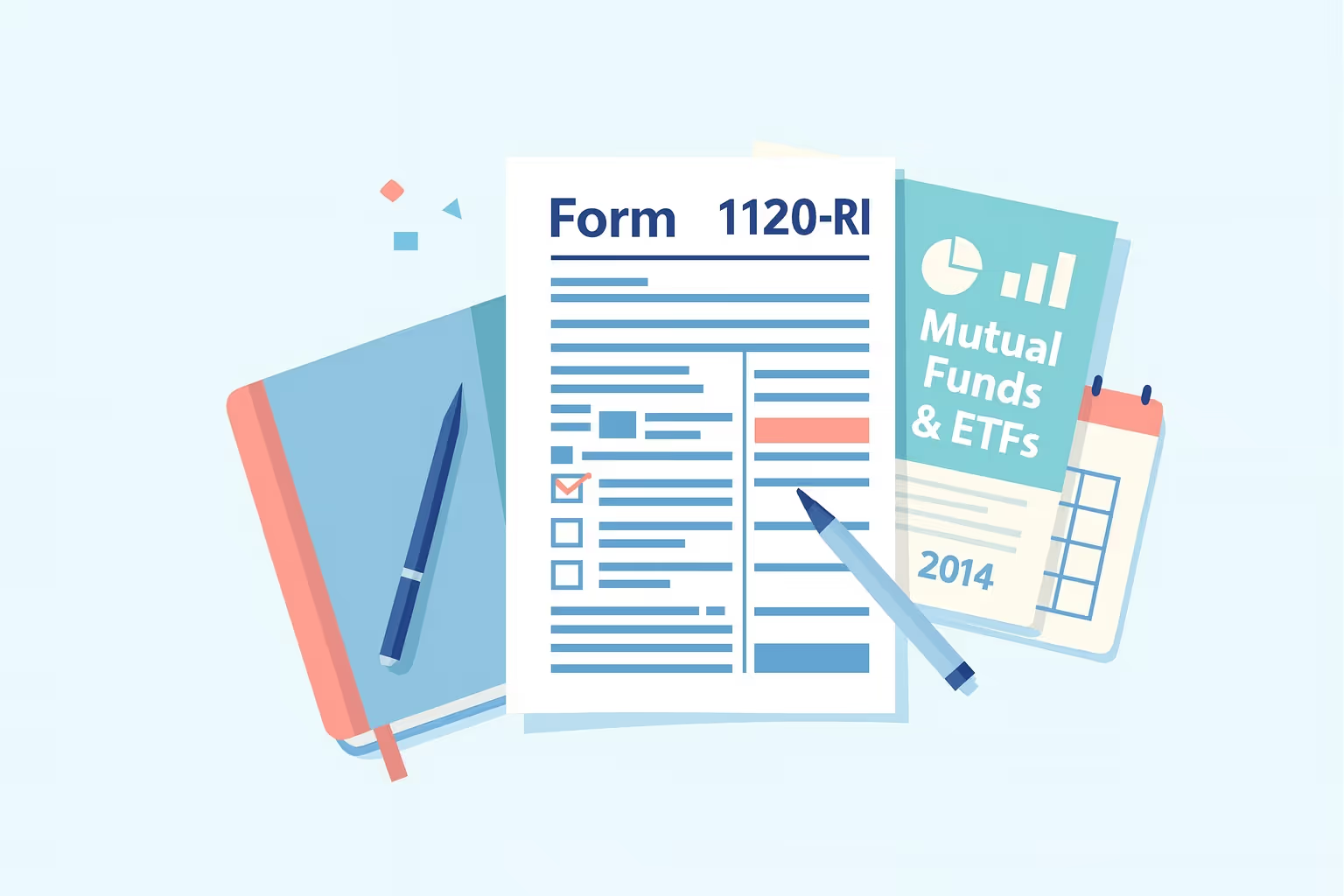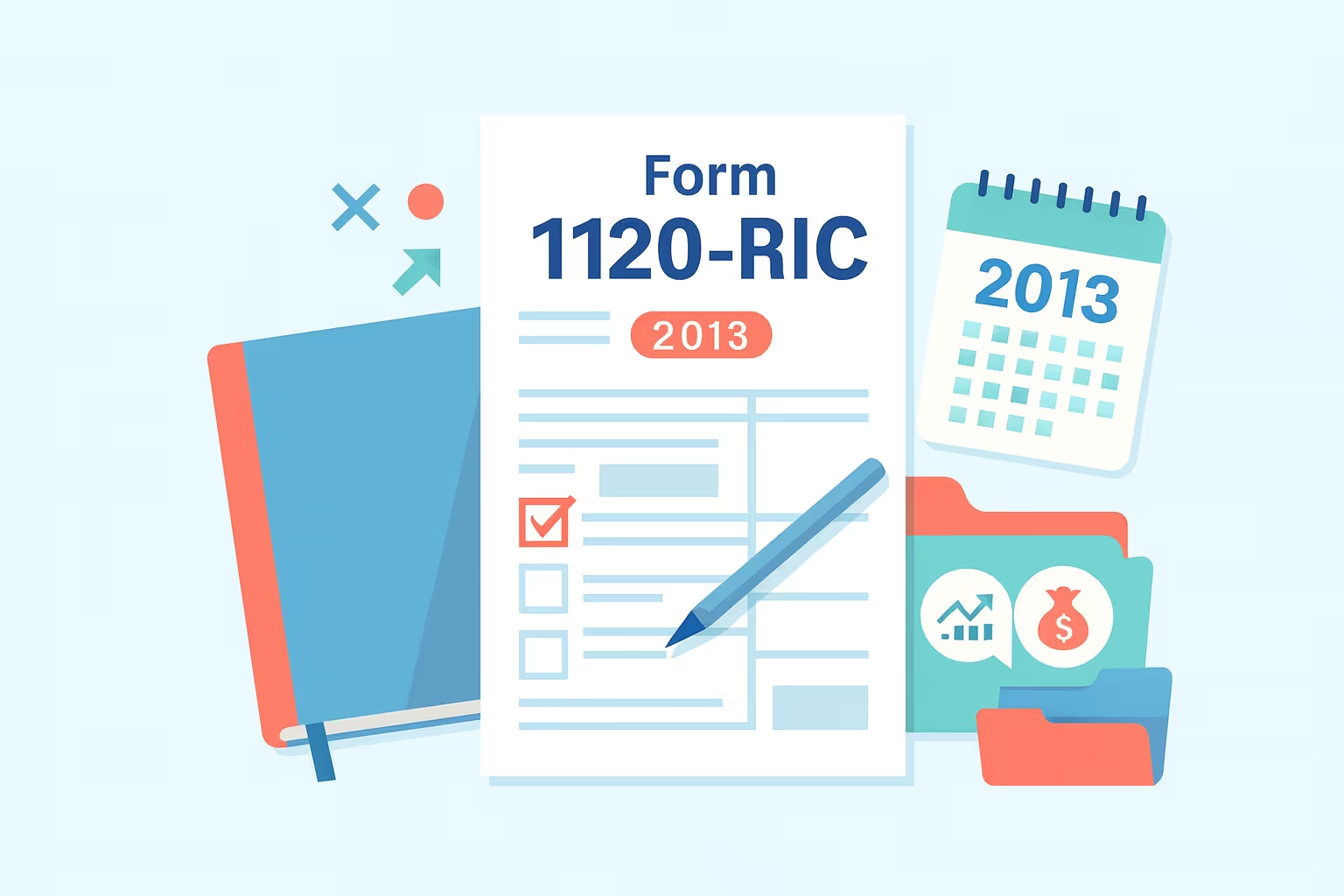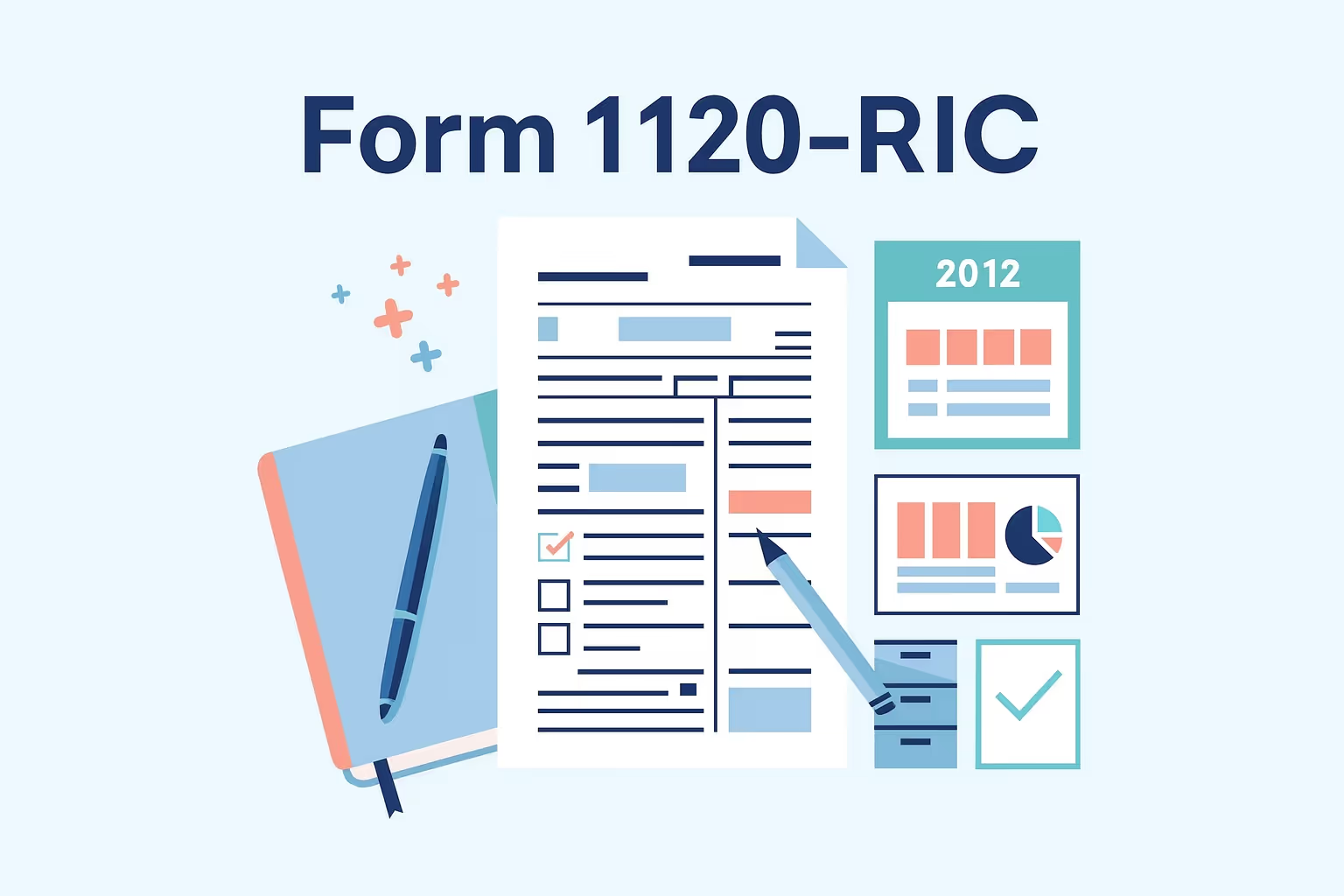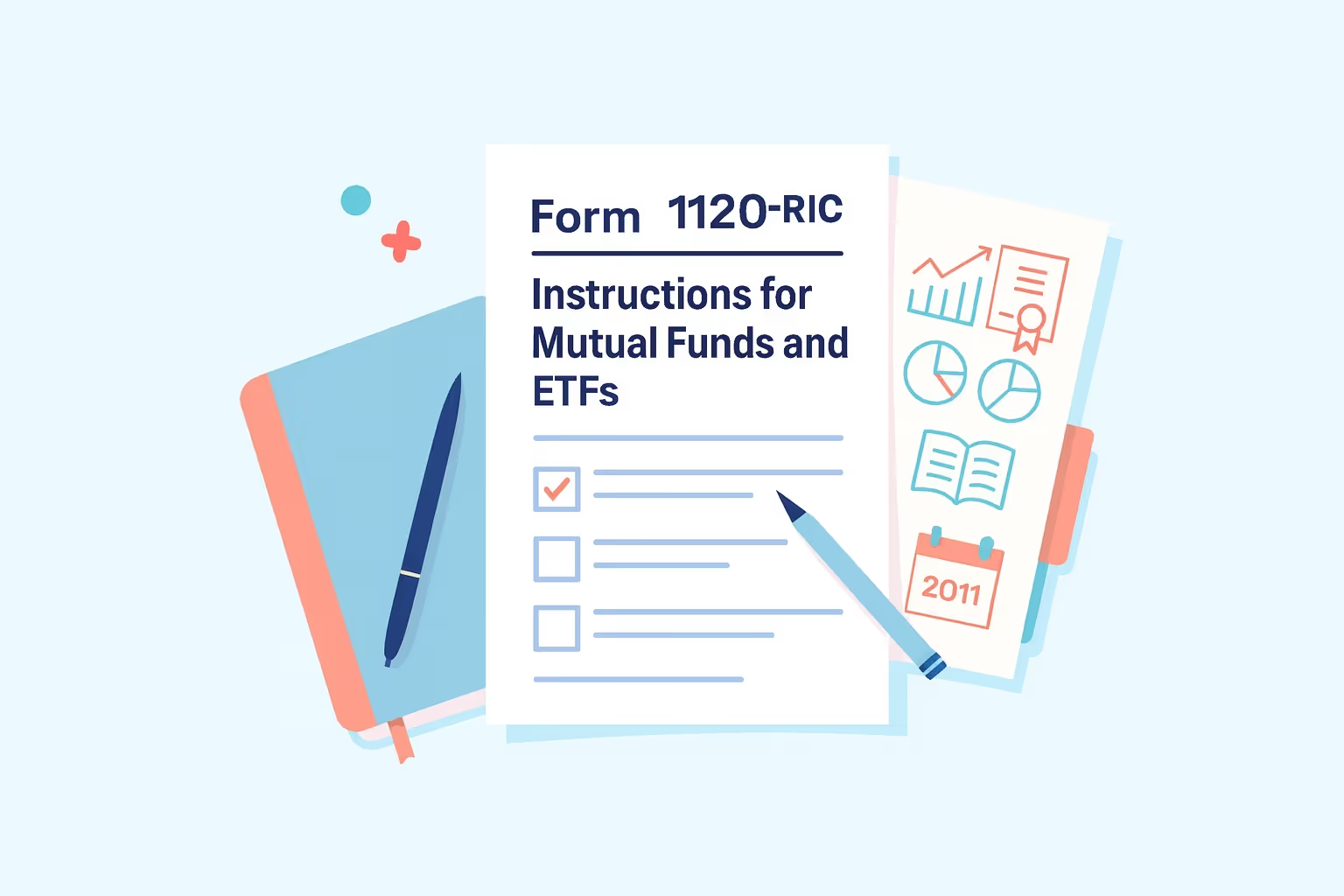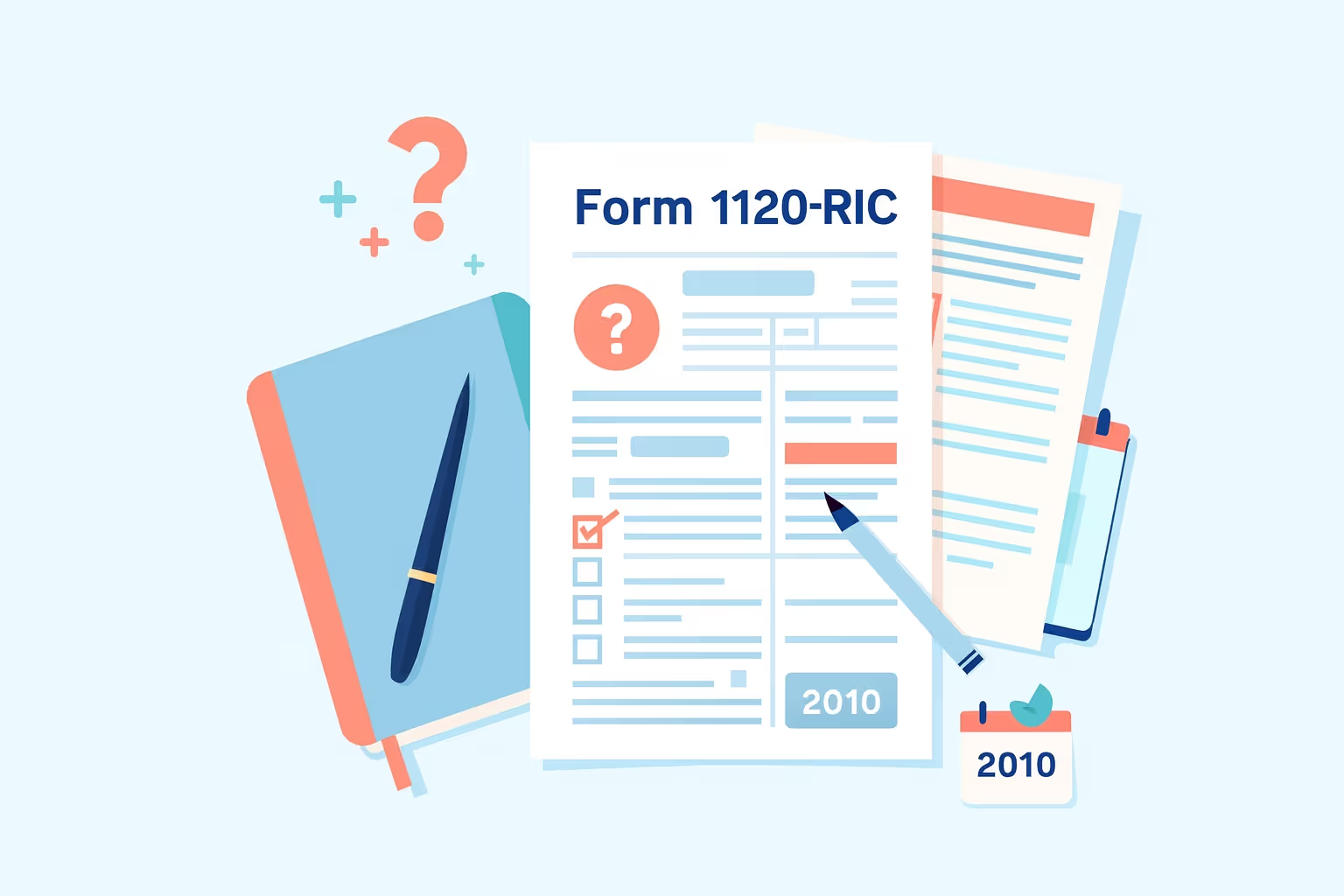
Filing taxes is stressful for individuals, but it can be even more complicated for regulated investment companies such as mutual funds and exchange-traded funds. According to the Internal Revenue Service, thousands of corporations are penalized yearly for late or incorrect returns, often because of overlooked requirements or misclassified taxable income. Regarding Federal Form 1120-RIC for Tax Year 2022, a single mistake can cost a fund hundreds of dollars in penalties, delay shareholder distributions, and create reporting issues with the Securities and Exchange Commission.
Federal Form 1120-RIC for Tax Year 2022 is not just another corporation income tax return. The official income tax return is designed for regulated investment companies under the Internal Revenue Code. Completing it accurately ensures the company correctly reports its gross income, net investment income, dividends paid, and other deductions. More importantly, it confirms compliance with tax regulations protecting the fund and its shareholders. Errors or omissions can trigger audits, create unpaid taxes, and in the worst cases, cause the loss of RIC status.
The goal of this guide is simple: to walk you through the filing process. Hence, your investment company stays compliant, avoids costly mistakes, and meets every reporting requirement set by the Internal Revenue Service. Whether you are a first-time filer or have years of experience, this guide will help you prepare, complete, and file confidently.
Understanding Federal Form 1120-RIC
Before completing the return, it is essential to understand precisely what Federal Form 1120-RIC for Tax Year 2022 represents and why it matters to regulated investment companies. This form is a cornerstone of compliance: it ensures that investment companies report their income, capital gains, deductions, and dividends in accordance with federal tax regulations.
What Is Federal Form 1120-RIC?
Federal Form 1120-RIC is the official U.S. corporation income tax return for regulated investment companies. It applies to mutual funds, exchange-traded funds, unit investment trusts, and specific business development companies that elect RIC status under the Internal Revenue Code. The form requires reporting gross income, investment company taxable income, and shareholder dividends. By completing it accurately, a domestic corporation demonstrates compliance with the tax rules that govern RICs and avoids unnecessary tax liability.
Who Must File and Why It Matters
Not every corporation files Form 1120-RIC. It is specifically required for companies that have elected RIC status and meet the qualification tests described in the Internal Revenue Code. Filing is not optional:
- A domestic corporation that fails to file risks being taxed as a standard C corporation. This typically results in higher tax rates and the inability to pass income through to shareholders without double taxation.
- Investment companies that ignore the filing rules can lose RIC status altogether, which directly affects their shareholders and creates exposure to penalties for unpaid taxes.
- The Internal Revenue Service requires that these returns be complete, with the correct employer identification number, applicable boxes checked, and financial statements attached. Missing information can delay processing and increase compliance costs.
Understanding who must file ensures that every qualifying investment company protects its status and meets the Internal Revenue Service's reporting requirements.
What’s New for Tax Year 2022
Before filing, regulated investment companies must know about updates affecting Federal Form 1120-RIC for Tax Year 2022. The Internal Revenue Service introduced changes that directly impact how investment companies calculate income tax liability and prepare their corporate income tax return. Understanding these updates helps avoid errors, penalties, and missed credit opportunities.
Increased Penalties and Updated IRS Forms
The IRS raised the minimum penalty for failing to file a corporation’s return that is more than 60 days late. The penalty for returns due in 2023 is the lesser of the unpaid tax or $450, compared to $435 in the prior year.
This increase emphasizes the importance of filing on time and paying taxes promptly. In addition, the IRS announced that the 2022 Form 1120-W and its instructions would be the final revision. After 2022, this form becomes historical and is no longer required for estimated tax calculations.
New Tax Credits and Limitations
The Internal Revenue Code also introduced changes affecting tax credits. Regulated investment companies may now elect to treat the advanced manufacturing investment credit under section 48D as a deemed payment of estimated tax. This provision gives more flexibility in managing cash flow and credit limitations. While COVID-related payroll credits have largely expired, certain employers that paid qualified wages in 2022 may still claim them if specific conditions are met.
These updates make it clear: companies filing Form 1120-RIC must pay close attention to new rules. Missing these details could lead to unpaid taxes, increased liability, or the loss of valuable credits.
Pre-Filing Preparation
Every regulated investment company filing Federal Form 1120-RIC for Tax Year 2022 should complete a thorough preparation process before filing the form. Proper preparation ensures accuracy, reduces the risk of missing deductions, and helps avoid unnecessary penalties.
Pre-Filing Checklist
The following steps should be completed before starting the return:
- Confirm RIC qualification tests: Each regulated investment company must verify that it meets the income, diversification, and distribution tests required by the Internal Revenue Code. A failure here could result in losing RIC status and higher tax liability.
- Gather financial records and statements: Income statements, shareholders’ share reports, and balance sheets prepared using the company’s accounting method will be needed to calculate gross income, taxable income, and dividends paid.
- Identify supporting IRS forms and schedules: Depending on the company’s activity, attachments may include Form 8613 for excise tax, Form 2438 for capital gains, or a statement of uncertain tax positions. Each must be assembled in the correct order as required by IRS regulations.
- Verify core information: Ensure the correct employer identification number is available, confirm the corporation’s return corresponds to the proper taxable year, and check applicable boxes such as final return, amended return, or ownership change.
Standard Documents You Will Need
Beyond the standard income and expense records, investment companies must keep specialized documents ready for filing:
- Securities and Exchange Commission: The compliance documents help prove the company continues to meet RIC requirements under federal tax regulations and securities laws. Each document should be dated appropriately and aligned with the tax year.
- Prior year corporation income tax return: Having last year’s Form 1120-RIC available helps ensure consistency in reporting income derived, deductions, and total assets.
- Shareholder distribution records: These reports show dividends paid, capital gains distributions, and any spill-over payments treated as part of the taxable year.
Completing these steps before filing helps regulated investment companies avoid costly mistakes and positions them to submit a compliant and accurate tax return.
Step-by-Step Filing Instructions
Filing Federal Form 1120-RIC for Tax Year 2022 involves multiple parts. Each form section is tied to regulated investment company requirements under the Internal Revenue Code. Following these steps carefully ensures accurate investment company taxable income, deductions, and tax liability reporting.
Step 1: Header Information
The top portion of Form 1120-RIC requires accurate identification details:
- Enter the year RIC status began and the date of establishment. Each entry must match records with the Securities and Exchange Commission.
- Provide the employer identification number. This number is unique to the domestic corporation and must be used consistently across all IRS forms.
- Report total assets from the balance sheet. This figure comes directly from Schedule L and reflects the company’s financial statements.
- Mark the applicable boxes. These include final return, amended return, address change, or ownership change. Using the wrong box can cause delays in processing.
Step 2: Part I – Investment Company Taxable Income
This section calculates taxable income before the deduction for dividends paid. Key income and deduction categories include:
- Income items: Report dividends, interest income, securities loans, net gain, other income, and income derived from foreign sources or controlled foreign corporations. Each entry must match the supporting schedules.
- Deductions: Record management fees, accounting and legal services, amortizable bond premium, transfer agent costs, and any deductions for political organizations. These must be supported by documentation.
The result is total income minus total deductions. This becomes the investment company's taxable income before considering the dividends paid deduction.
Step 3: Part II – Tax on Undistributed Net Capital Gain
If the company retains capital gains rather than distributing them, a 21 percent tax applies. Report these amounts on Part II, ensuring net income from capital gains matches Schedule D and other supporting IRS forms.
Step 4: Schedules and Attachments
Form 1120-RIC requires multiple schedules that must be attached in a specific order. These include:
- Schedule A – Deduction for Dividends Paid: This schedule reports ordinary dividends and capital gain distributions. It ensures that the deduction for dividends paid is correctly reflected when calculating the investment company's taxable income.
- Schedule B – Tax-Exempt Income: This schedule reports tax-exempt income and the related expenses that must be allocated against it. Proper completion prevents misstatements of net investment income.
- Schedule J – Tax Computation: This schedule computes overall tax liability, including applying credits such as tax credit bonds and other special rules. Accurate calculations and attached statements must support each entry.
- Schedule K – Other Information: This section requests additional details, such as uncertain tax position statements and information on ownership changes. The IRS uses these disclosures to evaluate compliance and reporting transparency.
- Schedule L—Balance Sheets: This schedule presents balance sheets from the company’s books, showing total assets, liabilities, and shareholder equity. The figures reported here must align with financial statements.
- Schedule M-1 – Reconciliation of Income: This schedule reconciles book income with taxable income reported to the IRS. It helps identify timing differences and ensures accuracy in taxable income reporting.
Additional attachments may include:
- Form 2438 – Undistributed Capital Gains: This form reports capital gains not distributed to shareholders and calculates the related tax liability. It is required whenever a RIC designates undistributed gains.
- Form 8613 – Excise Tax: This form calculates and reports the 4 percent excise tax on undistributed income. Filing is mandatory if the company owes excise tax or makes certain elections.
- Form 5471 – Controlled Foreign Corporations: This form reports ownership and transactions with controlled foreign corporations. It is a required disclosure for compliance with international tax rules.
- Form 1099-DIV – Dividends Paid documents dividends and distributions paid to shareholders. It must be issued to investors and filed with the IRS to confirm reporting accuracy.
Accuracy Tips for Each Step
- Always confirm that the total income matches the income statements and the attached schedules. Even minor discrepancies raise IRS review flags.
- Ensure deductions are correctly classified. Misclassifying expenses can reduce allowable deductions and increase tax liability.
- Review all applicable boxes for accuracy. An unchecked box may be treated as incomplete reporting.
- Attach all schedules and forms in the required IRS order. Omissions often delay processing or create reporting errors.
Completing each part with attention to detail ensures that the corporation’s return complies with IRS regulations. It helps the company avoid penalties, protect RIC status, and keep shareholder reporting accurate.
Filing Methods and Payment Instructions
Once Federal Form 1120-RIC for Tax Year 2022 is complete, the next step is filing and paying any tax liability. The Internal Revenue Service offers multiple methods, but choosing the right option affects speed, accuracy, and cost.
Electronic Filing Advantages
Electronic filing is the IRS-recommended method for regulated investment companies.
- E-filed returns are processed in days, while paper returns may take weeks. Faster processing also means faster refunds when tax credits or overpayments apply.
- Tax preparation software helps reduce math errors by validating entries before submission. This is especially important for complex returns reporting net income, dividends paid, and credit limitations.
- The IRS provides real-time confirmation that the corporation’s return has been received, offering fund managers peace of mind.
Paper Filing
Some corporations still use paper filing, although it is slower and riskier.
- Returns with total assets under $10 million are sent to the Kansas City IRS center. Returns with $10 million or more are mailed to the Ogden IRS center.
- Certified mail or a delivery service with tracking is strongly recommended. Without proof of delivery, an investment company could face penalties for unpaid taxes if the IRS does not receive the form on time.
Payment Options
The Treasury Internal Revenue Service requires prompt payment of any balance due:
- Electronic Federal Tax Payment System (EFTPS): This system provides immediate confirmation, the ability to schedule payments, and historical tracking of prior deposits.
- ACH or wire transfers: This type of transfer are useful for large payments, though banks may charge service fees.
- Checks or money orders: These are accepted only with paper filings and must include the employer identification number and tax year.
Comparison Table 1: Filing Methods
Comparison Table 1: Filing Methods
Electronic Filing
- Processing Time: 1–2 weeks (refunds typically issued within 30 days)
- Error Rate: Low, due to software validation
- Cost: Minimal
- IRS Confirmation: Immediate
Paper Filing
- Processing Time: 6–8 weeks (refunds often delayed)
- Error Rate: Higher, since data is entered manually
- Cost: Includes postage and handling fees
- IRS Confirmation: None, unless sent via certified mail
Submitting the form electronically while using EFTPS for payments is the fastest and safest way to file Federal Form 1120-RIC.
Required Attachments and Reporting Requirements
The Internal Revenue Service requires regulated investment companies to include specific schedules and supporting forms with Federal Form 1120-RIC for Tax Year 2022. Attaching the wrong forms or submitting them in the wrong order is one of the most common reasons filings are delayed. Following the IRS assembly instructions ensures the corporation’s return is complete and processed without unnecessary complications.
Assembly Order for IRS Forms
Attachments must be assembled in a precise order after page four of Form 1120-RIC:
- Schedule N
- Schedule D
- Form 8949
- Form 4136
- Form 8948
- Form 965-B
- Form 8941
- Form 3800
- Form 8997
- Additional schedules in alphabetical order
- Additional forms in numerical order
- Supporting statements and attachments
Any missing or misordered forms can create discrepancies in total income, tax liability, or reporting requirements.
Commonly Required Forms and Schedules
The following schedules and attachments are most often required with Form 1120-RIC:
- Schedule A—Deduction for Dividends Paid: This schedule reports ordinary dividends and capital gain distributions. It ensures that the deduction for dividends paid is correctly reflected when calculating the investment company's taxable income.
- Schedule B – Tax-Exempt Income: This schedule reports tax-exempt income and the related expenses that must be allocated against it. Proper completion prevents misstatements of net investment income.
- Schedule J – Tax Computation: This schedule computes overall tax liability, including credits such as tax credit bonds and other special rules. Accurate calculations and attached statements must support each entry.
- Schedule K – Other Information: This schedule requests additional details, such as uncertain tax position statements and information on ownership changes. The IRS uses these disclosures to evaluate compliance and transparency.
- Schedule L – Balance Sheets: This schedule presents balance sheets from the company’s books, showing total assets, liabilities, and shareholder equity. The figures reported here must match the financial statements.
- Schedule M-1 - Reconciliation of Income: This schedule reconciles book income with taxable income reported to the IRS. It highlights timing differences and ensures that the net income derived is accurate.
Additional attachments may include:Form 2438 for undistributed capital gains, Form 8613 for excise tax, Form 5471 for controlled foreign corporations, and Form 1099-DIV for dividends paid to shareholders.
Comparison Table 2: Schedules vs. Supporting Forms
Schedules
- Schedule A
- Purpose: Deduction for dividends paid
- When Required: Always required for RICs distributing dividends
- Schedule J
- Purpose: Computes total tax liability
- When Required: Always required
Supporting Forms
- Form 2438
- Purpose: Reports undistributed capital gains
- When Required: When gains are not distributed to shareholders
- Form 8613
- Purpose: Reports excise tax
- When Required: When subject to excise tax or making elections
- Form 5471
- Purpose: Reports controlled foreign corporations
- When Required: When the RIC owns foreign corporation stock
- Form 1099-DIV
- Purpose: Documents dividends paid
- When Required: When distributions are made to shareholders
By ensuring all attachments are complete and properly ordered, regulated investment companies can avoid IRS processing delays and reduce the risk of inquiries about missing information.
Common Mistakes and How to Avoid Them
Errors on Federal Form 1120-RIC for Tax Year 2022 are common, even for experienced investment companies. These mistakes can lead to penalties, increased tax liability, or loss of regulated investment company status. By understanding where most corporations go wrong, you can take steps to avoid them.
Qualification Test Errors
The Internal Revenue Code requires RICs to meet specific qualification tests. Failure to comply can disqualify the company:
- Income test errors: Some funds fail to confirm that 90 percent of gross income is derived from allowable sources such as dividends, interest, and securities loans. Not meeting this standard results in higher taxation.
- Asset test violations: Failing to diversify assets early is a frequent problem. Missteps here can cause an RIC to lose its status and face taxation like a standard corporation.
- Distribution shortfalls: Not distributing at least 90 percent of taxable income can create additional liability and excise taxes.
Filing and Schedule Errors
Mistakes in filing or attaching schedules are among the most preventable:
- Math mistakes: Small errors in calculating taxable income or deductions can create reporting discrepancies and potential audits.
- Incorrect or missing schedules: Leaving out schedules such as Schedule J or Schedule M-1 often delays processing.
- Wrong taxable year: Filing with the wrong tax year information invalidates the corporation’s return.
Distribution-Related Errors
Distributions to shareholders must be calculated carefully:
- Misclassification of dividends: Some companies misclassify ordinary dividends as capital gain distributions, affecting the deduction for dividends paid and shareholder reporting.
- Timing mistakes: Failing to meet deadlines for spill-back or post-year-end distributions can eliminate otherwise allowable deductions.
Avoiding these common errors protects regulated investment companies from penalties, ensures compliance with IRS regulations, and secures accurate reporting for shareholders.
FAQs
When is Federal Form 1120-RIC for Tax Year 2022 due?
Federal Form 1120-RIC for Tax Year 2022 is due on the 15th day of the 4th month after the end of the taxable year. For calendar year filers, this means April 15, 2023. If the company operates on a fiscal year, the deadline shifts accordingly. Filing Form 7004 provides an extension to file, but payment of income tax liability must still be made by the original due date.
What happens if a regulated investment company misses the filing deadline?
Missing the deadline for filing Form 1120-RIC creates immediate consequences. The Internal Revenue Service applies a penalty equal to the lesser of the unpaid tax or $450 for returns filed more than 60 days late. Interest charges also accrue on unpaid taxes. Beyond financial penalties, late filing risks delays in processing shareholder distributions and can trigger IRS scrutiny of the corporation’s return, increasing compliance costs.
Do mutual funds and exchange-traded funds file differently from other corporations?
Yes, mutual funds, exchange-traded funds, and unit investment trusts that qualify as regulated investment companies file Federal Form 1120-RIC rather than the standard Form 1120 used by C corporations. This allows them to report investment company taxable income, deductions, and dividends paid to shareholders. Failing to file the correct corporation income tax return could disqualify the company from RIC status, leading to double taxation on net income.
What is Form 8613, and when must it be filed?
Form 8613 is the Return of Excise Tax on Undistributed Income. A regulated investment company must file it when it does not distribute at least 98 percent of its ordinary income and 98.2 percent of its capital gains. The form calculates the 4 percent excise tax imposed under the Internal Revenue Code. Even if no tax is due, Form 8613 may still be required when elections under section 4982 are made.
Can regulated investment companies use tax preparation software for Form 1120-RIC?
Yes, the IRS accepts electronically filed corporation income tax returns through approved tax preparation software. Software reduces errors, validates income and deduction entries, and confirms that the return has been received. Many investment companies prefer this method because refunds are processed within 30 days compared to the slower paper filing process. Software can also help manage supporting forms, such as reporting requirements for controlled foreign corporations.

























